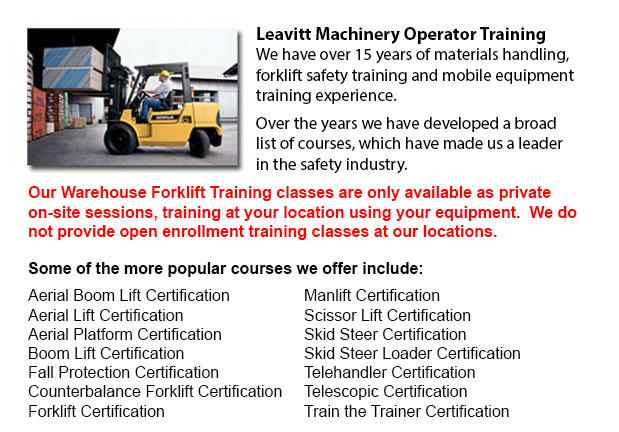
Warehouse Forklift Safety Training Brampton - Businesses normally face liability for injuries and damage sustained in workplace accidents. Warehouses can be dangerous places to the people who work there. That is why employee safety is a top priority for numerous businesses. Warehouse safety training is one of the most effective ways to protect staff, while minimizing costs associated with accidents and injuries.
Warehouses hold stock which could present a variety of dangers, particularly related to materials handling. Moving stock, either by hand or utilizing powered machines, can cause injuries to employees' fingers, hands, toes and feet. Slipping, tripping and falling are common reasons for injury. Heavy things can fall off shelves and harm personnel. Forklifts and other equipment carry inherent dangers because they manipulate heavily laden pallets. Incorrect lifting is a common source of back injuries. Even nails, splinters and box cutters can result in harm.
Depending upon the goods and materials which are being handled, the conditions of the warehouse can change from one moment to the next, specially with the machine being utilized and the work being carried out. Due to the wide variety of possible dangers in warehouse settings, warehouse operations are regulated by many different standards. There are regulations for material handling and storage, for working and walking surfaces, and rules governing the selection and use of PPE (personal protective equipment).
The majority of the safety regulations covered by a company would consist of common sense regulations. Rules which warehouse staff must be quite familiar with include:
1. When working in a warehouse, safety is a priority at all times.
2. When work calls for proper PPE, like safety shoes, gloves, eye protection and hard hats, they must be worn.
3. Inspect for hazards and report them or correct them.
4. Observe and Obey warning signals and signs.
5. Pay attention to the job you are doing.
6. Pay attention to what others are doing nearby - especially forklifts and other dangerous equipment.
7. Make certain that stacked products and materials are secured and stable.
Adherence to good housekeeping regulations would help to guarantee a safe warehouse for all workers. Essential housekeeping regulations involve keeping floors and aisles clear of items, such as wires and cords. Never perch objects insecurely on a surface. When spills happen, clean up immediately. Dispose of trash in correct containers. Keep fire exits, fire extinguishers and sprinklers accessible. Put box cutters and various sharp tools away immediately after using. Report tripping hazards such as loose or damaged flooring.
-
Boom Lift Operator Training Brampton
Boom Lift Operator Training Brampton - A cherry picker is a type of aerial work platform. Cherry pickers consist of a platform or bucket at the hydraulic lifting system's end. The device is also called a man lift, boom lift, basket crane or hydraladd... More -
Forklift Instructor Training Brampton
Forklift Instructor Training Brampton - For those lift truck operators who want to become a forklift instructor it is recommended that they complete a forklift Instructor training certification program. Entry qualifications for the forklift instructo... More -
Manlift Certification Brampton
Manlift Certification Brampton - The Manlifts and Elevated Platforms program offers training on the regulations, rules and correct application of safe operating measures and work practices involved in daily activities for those who work using this ma... More -
Telehandler Training in Brampton
Telescopic handlers normally called telehandlers for short, are a really popular piece of heavy construction equipment. They are usually used in the construction and agricultural trades. These machines have farthest reaching capacity and are able to... More -
Order Picker Training Brampton
Order Picker Training Brampton - The order picker lift truck allows for people working in a warehouse setting to lift pallets making use of forks. This electronically-powered machinery is also referred to as a stock picker and is similar to a forklif... More -
Zoom Boom Ticket Brampton
Zoom Boom Ticket Brampton - Zoom Boom Training focuses on correctly training prospective operators on variable reach forklifts. The training objectives include gaining the knowledge of the equipments physics and to be able to define the tasks of the... More -
Crane Training Schools Brampton
Crane Training Schools Brampton - Our different Mobile Crane Operation programs are meant for experienced operators who requires re-certification or certification, and for inexperienced people who are searching for their first job as a crane operator... More -
Crane Safety Training Brampton
Crane Safety Training Brampton - Both crane operator as well as their employers need to be aware of all the potential problems associated to the use of an overhead crane. All across North America, there is legislation which provides rules for the saf... More

Forklift Training Brampton
TOLL FREE: 1-888-254-6157
Brampton, Ontario
forklifttrainingbrampton.ca
Email Us
About Us


